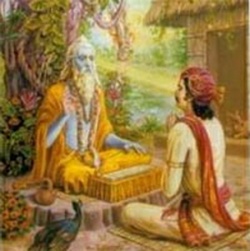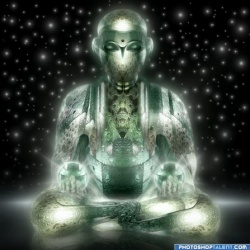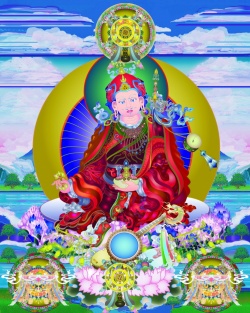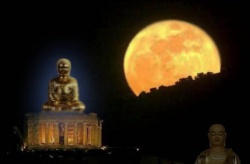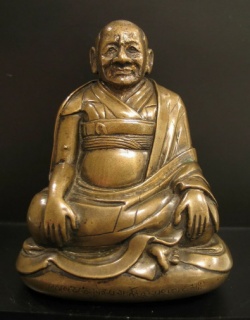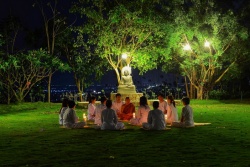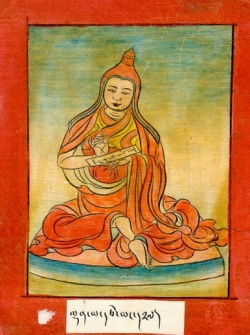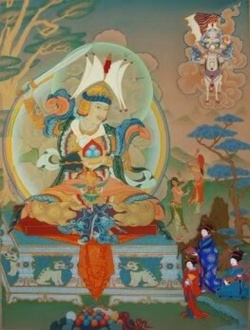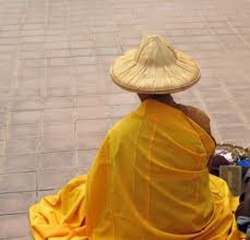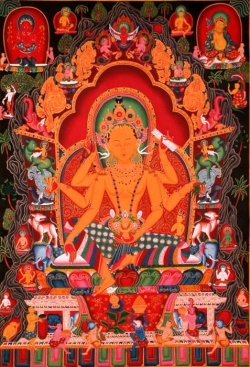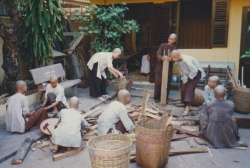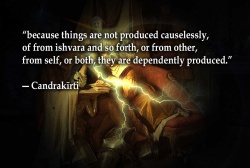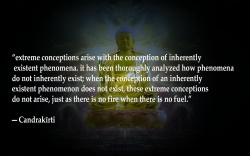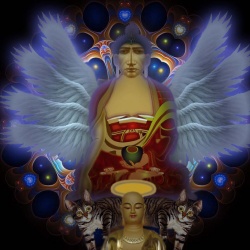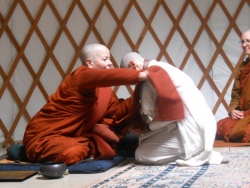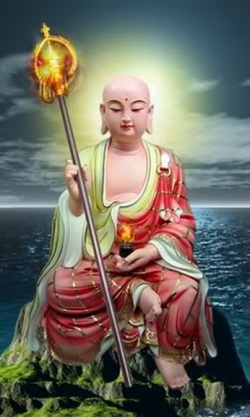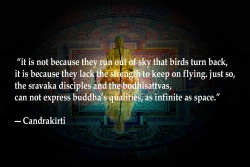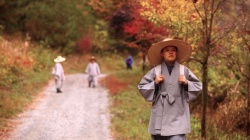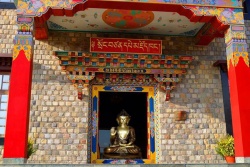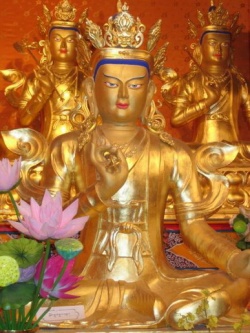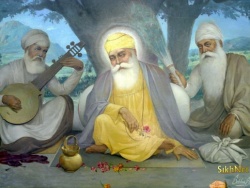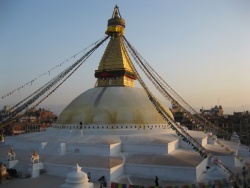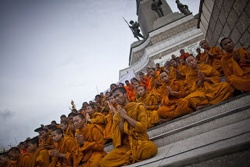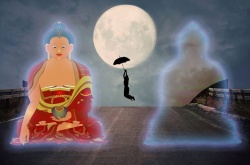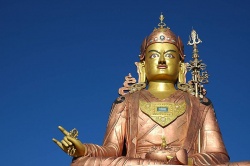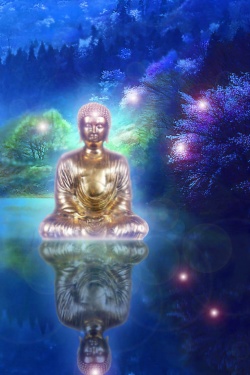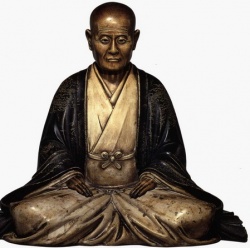The Sutra on The Full Awareness Of Breathing.
Today is January 18, 1998 we are in the Upper Hamlet. Today we are reading the poem about impermanence. This poem reminds us that our lives change every day, every minute, every second in order for us to live more diligently. This is the evening chant for Monday evening. "This day is already over. My life is shortened. I try to live more deeply. What have I done with my 24 hours?" The Gatha continues...I look deeply, what have I done with this day? Perhaps during this day, because of my forgetfulness has led me to be angry with someone. I was irritated. I have not treasured my 24 hours. That is what I have done. I look deeply to see what I have done. Have you made one step toward mindfulness? Have you lived your life deeper? Have you tried to do something good for someone you love and someone you don't love? Have you tried to transform a number of your negative energies?
I propose when you read these Gathas you read very slowly in order to have time to look deeply. In the Sino-Vietnamese text there is an imagery of a fish who sees the water in its pond becoming less. You are the fish living in that pond whose quantity of water becomes less and the fish starts to become worried. So our practice is to live deeply in the present moment, our wisdom is to see that we are inter-dependent. I did not put this imagery into the poem in Vietnamese because the imagery of the fish is too anguished and I think that is not part of my teaching. The teaching should be to look deeper and to transmit all your wisdom to others. So even if the water is no longer there you can continue to be other things and not just the fish. So there is no fear.
We only try and look deeply so that we are our own architect of our own life. You construct your own life. You do not regret anything because you have the decision to construct your own daily life and when you ask yourself "What have I done during this day?" you have to stop and look deeply. I decided not to put this imagery of the gatha into the Vietnamese version because I remember in the past when I wrote it from the Chinese version of the fish in despair because of the water in its pond being drained, people became dispirited. We know that when we cease to be this body we will be something else wonderful so we have no fear and no sadness. One day is very short so I must look deeply to see what I have done during that day and urge yourself to be more diligent. The Sangha should be very diligent and practice whole heartedly and try to live deeply our lives with a lot of freedom. We have to remind ourselves that life is impermanent and don't let every second, every minute go by in forgetfulness. Without mindfulness you cannot live deeply your life. When you live your life deeply every day is fine. This Gatha is to remind ourselves that life is impermanent and that everything changes. What you live today will change tomorrow but if today is lived deeply and if tomorrow it changes, this will also be very deep. Every change is a treasure. We have no fear. Every changing moment will be a new experience, a wonderful experience. We don't have to be fearful. I have made some changes to the poem in Sino-Vietnamese like the patriarchs have done in the past.
When you look at the sunset-- you know that the sunset can last only 5-10 minutes. During this 5 or 10 minutes you look deeply. There is this wonderful sunset in this second and the next second another wonderful sunset. You observe hundreds of seconds of this sunset. Hundreds of different moments. Every moment is a treat. Every moment is a joy. So after the sunset you enjoy other non-sunsets -- when you look deeper. Every moment you look deeply you are not attached. Each wonderful moment leads to another wonderful moment. You are not stuck to the beauty of the sunset because after the sunset, there are other beautiful things. To be happy as a 20-year-old is wonderful, so too as a 30-year-old. Being 40 years old is also wonderful. 80 year old is also wonderful. If at 20 years old you live deeply, you are alive. And if at30 year old you live deeply-- you are alive. You enjoy every moment of your life because you have lived deeply every moment of our life.
A number of us when we came here we think we must go to another place to be happy. Before going to this other place you dream a lot about that place and when you arrive you say, "Oh, it is nothing interesting" so you dream of yet another place. There are these people who go around dreaming of other places. If, at first sight, you see that it is not interesting, then you dwell deeply in the present moment in concentration and you then discover many wonderful moments in that place where at first you felt that there was nothing of interest. So every moment is a wonderful moment, if you live deeply and if you live without attachment you live in freedom. You enjoy every moment. You know that life is about change. Don't let any moment pass in forgetfulness. So I wish you to learn and practice this poem. We will go to the next chant, the chant for Tuesday morning.
We always begin by siting meditation and the slowing walking meditation around the zendo before we start the chanting. We turn our attention to the Buddha and the Sangha in the Katha Mountain, meaning that everyone in the Sangha will be together facing the Buddha. We go to the Anapanasati Sutra, the Sutra on the 16 methods of breathing taught by the Buddha. The other day Thay received a letter from a Spanish woman of 23. She was so impressed after reading Thay's book she said, "thanks to your book I discover something very wonderful. I only need to go back to my breathing and then I have happiness. How things are so simple! I tried it and it really works. Really. As I go back to my breathing and look deeply into the present moment suddenly I realised I am very happy. In the past I looked for my happiness in dreaming about this or that and I am not satisfied when I have them. I never have happiness. After reading your book I go back to my breath and I look deeper and I say "Oh, how wonderful1" looking into my present moment at the conditions available to me. I discover that I am so happy. At 23 I have my youth and I have good health. I have all the conditions to be happy. Yet, in the past, I was running and searching for happiness. It is so wonderful and I want to come here." Thay was the same. The day he discovered this Sutra he was so happy because in the past he tried to learn this sutra and was satisfied with a lot of knowledge but he didn’t know how to enjoy the present moment. He did not know how to look deeply into this life, where he was able to enjoy his youth, the conditions he had. So the day he discovered this Sutra he was so happy, he thought he discovered the greatest treasure in the world. That Sutra is called Anapanasati in Pali.
Looking deeply into the first exercise, breathing "In and Out". This Sutra has been circulated in Vietnam during the first century after Christ. The one who translated it was An The Cao. He was Chinese and lived in China but because there was a war in China so he went to Vietnam at that time called Giao Chau, the former name of Vietnam. When he arrived at Giao Chau he saw a larger centre of practice of Buddhism than where he was back in China. He met with a teacher called Tang Hoi whose parents were of Sochen origin. The family emigrated from India to Vietnam because they were commercial tradespeople. His father married a Vietnamese girl and then when they gave birth to a little child both of them died. This orphan was taken care of by the monks in a temple and later went on to become a very famous monk called Tang Hoi. He became the abbot in charge of a large practice centre in Vietnam. When An The Cao went to Vietnam he came across this large Buddhist centre where Tang Hoi belonged. Tran Tue brought to Tang Hoi this sutra and asked him to do a commentary on it and he would write a foreword. Tran Tue made commentaries on this. We then put this into the Tripitaka. In Chinese you have this Sutra translated by Tang Hoi and placed in the Tripitaka. This sutra has been translated into Vietnamese by Thay and has been published in the Vietnamese Buddhist history. Sister Chan Duc has already translated these parts into English. All these stories took place around the 3rd century. Tang Hoi translated many sutras into Vietnamese and at the end of the 3rd century he went to China in order to teach Buddhism to the Chinese. When the Chinese came to Vietnam they destroyed all our books and history so we had to restore them. Thanks to the Chinese history, we discovered Tang Hoi came from Vietnam because it was described that Tang Hoi was a Chinese monk who came from a small province of China called Giao Chau. They called Giao Chau a little province of China. It was also the largest Buddhist centre in the country.
It is said that this monk was half-Vietnamese and half-Indian. He travelled from south to north and converted King Ngo Dong Quyen into Buddhism. After this the first Buddhist temple was built. King Ngo Dong occupied a large amount of the southern state of China. He was so impressed by Buddhism and built beautiful temples. We only need to know that this sutra existed in Vietnam at the beginning of the third century. The Vietnamese practised a lot of these sutras around Vietnam. The one we are reading here I translated not from the Chinese but from the Pali Sutra. In the Chinese text of the Tripitaka this sutra has the name "The Great Sutra on Breathing". In this Great Sutra I don't know why the main text is not very clear. Why the commentaries are so long. Why the main text was not very obvious-- not very simple and clear like it is in the Pali text. That is why I use the Pali text in order to translate directly into Vietnamese.
This sutra exists in many other sutras in Chinese. It is also in the Agama sutra. If I combine the three sutras; 815, 803, and 810 of the Agama then these three together equals the Anapanasati sutra in Pali. There are so many parts lost whilst the commentaries remain I discovered these 16 exercises in the Pali canon. In the Majimanikaya 180 everything is so simple and very clear, the 16 exercises put in a very clear way. So when I read these three sutras in the Chinese canon I see them in the Majimanikaya 180, they are almost 95% correct and similar, there are a few differences that are not so important.
This Sutra has been transmitted in Sanskrit by the Sravasti School in Kashmere and transmitted in Pali in Sri Lanka. What has been transmitted verbally into Sanskrit and verbally and directly into Pali spread to Sri Lanka and then to northern India and then to China. And now 2500 years later you find almost the same translation. It is so wonderful. When the Buddha gave the teaching he gave it verbally. He refused to use any complicated writing; he said he wanted people to practice more than to be scholars. It has been transmitted verbally many hundred of years before it was written down into Sanskrit in the northern part of India and into Pali in the eastern part of India. After that it spread into all the countries in the south. The Sanskrit version spread into many countries in the north like Tibet, Bhutan and China. After 2500 years we compare these two versions and we find they are almost the same. It is wonderful.
The Sutra was given by the Buddha in Sravasti in the state of Kusala. It is so basic and so wonderful. There are so many great sutras but without this one it is like you want to go to the top of the mountain but there are no path leading there. This sutra is like the stairs for you to climb into the most beautiful Sutra of Mahayana Buddhism. When I discovered this Sutra I felt so happy.
In the time of the Buddha there were neither fax nor telephone. So disciples of the Buddha would hear of him giving teachings but would not know where, in which region. Thus there was an agreement that after a 3-month rains retreat, the Buddha stayed in Sravasti in order for all his disciples from different parts of the country to have the chance to come and listen to him. So usually after the 3 months rains retreat in Sravasti the Buddha would stay an extra 4th month. It was on the occasion of the full moon day of the fourth month of the rains season that the Buddha taught this Sutra.
At that time in Sravasti in the Jeta Grove there were many famous disciples of the Buddha like Shariputra, Moggallyana, Kassapa, and amongst them there were elder monks and young monks, those who already have the lamp transmission and others not yet with transmission but are still regarded as Dharma teachers if they had under went at least 5 consecutive rains retreats. So they have the duty to take care of themselves and the younger brothers in the Dharma. The senior Bikkhus in the community were diligently instructing the Bikkhus who were new in the practice. Some instructed 10 students, some 20 students, others 30 or 40.
When you are a novice you have to take refuge in one older sister or brother in the practice. So as a Bhikkhu or Bhikkhuni after 5 years of practice you have the duty to take care of the novices and younger Bhikkhunis or Bhikkhus .
We have to organise in such a way that those who have just become a novice monk or nun must have a supporting brother or a supporting sister. Those who practice longer not only take refuge in the elders in the practice but have to take care of the younger persons in the practice too.
There are those who might have just received the big ordination and become a Bhikkhu or Bhikkhuni and think "Now that I am a Bhikkhu/ni can I leave the community?" In fact Thây says that it is the actual beginning of the training and not a time for leaving.
That night there was a full moon. Lord Buddha was siting in the open air and his disciples were gathered around him. Looking over the assembly he begun to speak;
"Oh, Bhikkhus, I am pleased to observe the fruit you have attained in your practice. Yet I know you can make even more progress." The Buddha praised his community of practice. He didn't praise his own community to other people but when he praises it was to encourage the community to be diligent in the practice.
He said that he is very pleased that in his community of practice there are those who are mature, there are those who are not mature but trying their best to practice. "Our community of practice is truly a community of practice. Our community is not adorned with superficial things. I see that you all are young in the practice but you all practice properly and I am very pleased that you practice according to the teaching.
"Our community is like the field of merit. When people make offerings to this community they make a real investment because this community is really practising sincerely in order to spread the Dharma."
"Dear Friends:
In our community I see those who have attained Arahantship". An Arahat is somebody who deserves to receive offerings. An Arahat is someone who is able to transform all the negative energies like anger, hatred, craving, doubt, jealousy, and so on.
We call those who deserve to receive offerings Arahats because they have already let go of all afflictions and have attained great wisdom and liberation.
"And there are those who are able to cut off all attachments and have attained the state of No Return" -- it means you decide to go on the right path and you will never return to the path of the bandit, of the pirate, of the negative things.
Like those who have been a drug user and although they decide to give up drugs, but they still long to go back to taking drugs again, even if they have the good intention to stop.
When conditions are not favourable they are always pulled by the conditions to use drugs. When these drug users decide to practice properly they arrive at the state called ‘no return’ meaning they taste all the good fruits of not taking drugs. No Returning to the direction of drugs, of heroin, of alcohol, of negative things. When you are carried away by all these things you are swallowed by craving, by anger, by crime. The Buddha said to his gathering of disciples "Among you are those who have attained the state of No Return, Arahantship, and have already cut all afflictions and burdens and realised Great wisdom. No return means to cut the Five Hindrances: craving, anger, confusion, doubt, and arrogance. Those who have cut all five hindrances have arrived at the state of No Return. Others who have cut the first three hindrances: craving, anger, and confusion but still have some arrogance, some doubt, attain the state called Once-Returner. They still have to transform their most subtle negative energy.
By cutting the first three hindrances you attain Stream Entry. You enter into the stream of the community of practice. Entering the Stream is to join the great many others who are practising. By continuing to practice you gradually arrive at these different states. When you become a Stream-enterer it is like entering a stream of water that will take you to the ocean. It means entering into the stream is already a big step. So even if you don't come to practice for long, since you have decided to come here you have already entered into the stream.
"There are those of you who practice the Four Foundations of Mindfulness ."
There are those who are practising the Four Dilligences which is to develop that which is good and positive already present in you. If you observe your good energy you develop your good energy . If you observe your negative energy you learn ways to transform them.
"There are those who practice the 7 Factors of Enlightenment, there are those of you who practice Maitriya, others who practice Karuna, Upecha, others who choose the practice of looking at the impermanence of the body."
So each person has chosen the appropriate practice for his or her body or mind. All are learning ways to practice faithfully according to their appropriate path and the Buddha is very pleased with everyone.
"There are those who practice the Four Right Efforts.
There are those who practice the Four Bases of Success.
There are those who practice the Five Faculties
There are those who practice the Seven Factors of Awakening.
There are those who practice the Noble Eightfold Path.
There are those who practice Loving-Kindness.
There are those who practice Compassion.
There are those who practice Joy.
There are those who practice Equanimity.
There are those who practice the Nine Contemplations.
There are those who practice the Observation of Impermanence.
There are also Bhikkhus who are already practising the Full Awareness of Breathing. From practising the Four Foundations of mindfulness by following your breathing you will arrive at the practice of the Seven Factors of Enlightenment."
When you practice the Seven Factors of Enlightenment you will not leave your conscious breathing. If you practice diligently the Seven Factors of Enlightenment you arrive at deep insight and liberation.
Don't say that if you practice conscious breathing you will then arrive at the Four Foundations of Mindfulness. Don't say that only after the Four or Five Measures of Mindfulness you then arrive at the Seven Factors of Enlightenment. No, you have to practice conscious breathing in every state until you are liberated. Even while you are practising the Foundations of Mindfulness or practising the Seven Factors of Enlightenment you always practice conscious breathing. With the conscious breath you arrive at deep insight and liberation. I am sure even after the Buddha was enlightened he continued to follow his conscious breathing.. Conscious breathing means you are always the master of yourself. You are the conductor of your own car. You know how to handle yourself in a wonderful way. Even if you become a Buddha you must continue nourishing your body and your mind in a wonderful way. If you leave your conscious breath you can be pulled away by other things. So even if you become a Buddha you continue to practice conscious breathing in order to be in touch with what is wonderful.
"Bhikkhus, the practice of the Full Awareness of Breathing if developed, practised continuously will have great reward and bring great advantages. It is like this; the practitioner goes into the forest or to the foot of the tree or to any deserted place, sits in stability in the lotus position holding his or her body quite straight and practices meditation.
Breathing in I know that I am breathing in; Breathing out I know that I am breathing out.
Breathing in a long breath I know I am breathing in a long breath.
Breathing out a long breath I know I am breathing out a long breath.
Breathing in a short breath I know that I am breathing in a short breath.
Breathing out a short breath I know that I am breathing out a short breath."
This is the second exercise in the Chinese text. There are 16 exercises. In the Pali text there is not the words " I know." So in the Pali text it is:
‘Breathing in, I am breathing in.’
‘Breathing out, I am breathing out’, but this is not part of the first exercise.’
In the Chinese text it differs:
‘Breathing in I know I am breathing in.
Breathing out I know I am breathing out’, and this is the first exercise.
The second exercise in the Chinese text is:
‘Breathing in a long breath or a short breath I know that I am breathing in a long breath or a short breath.
Breathing out a long breath or a short breath I know I am breathing out a long breath or a short breath’.
The Pali text begins straight away with the exercise; ‘Breathing in a long breath…’. I think the Chinese text is more logical, it starts more logically;
‘Breathing in I know that I am breathing in.
Breathing out I know that I am breathing out’.
The second exercise is:
‘I know that my breath is long or short. Breathing out I know that my breath is long or short.
So I want to advise you to look at the exercises to see which part is good for your practice and which is not good. There are those who are not very intelligent in their practice, when they hear the Buddha teach; ‘Breathing in a very long breath—‘ they then force themselves to have a long breath in order to be faithful to the words given in the exercises by the Buddha. Throughout your day you are forgetful and you are not aware that you are breathing. And therefore the first exercise is to bring you mind to your breath.
‘Breathing in I know that I am breathing in’. I am not thinking of something else. ‘Breathing out I know I am breathing out’ . This is the first exercise to bring our mind back to our breath.
The second exercise is to recognise whether the breath is long or short. You respect your breath as it naturally is, whether it is a long or a short breath.
‘Breathing in I am aware that I have a long breath.
Breathing out I am aware that I have a long breath’.
So the second exercise is to recognise what kind of breath you have.
In the first exercise you recognise a very simple and miraculous thing. You bring your mind back to your body and to your breathing. You suddenly see, "Oh, I am breathing in, I am breathing out". Just recognise and identify with your breathing.
When you are breathing in you know that you are breathing in. Breathing out you know you are breathing out.
You only need to use one word; ‘In’ or ‘Out’. Your attention is fully with the length of your breathing. Your mind can be thinking of many things so to help focus your attention you can say "In" for the whole of your in breath, saying "in, in, in, …". As long as your mind is totally with the in breath as you are saying this, this is fine. By saying "….I know that I am…", the word "know" means you bring all your attention and all your mind to the In and Out breath. Because you bring all your attention to your breath you let go of all worries, anger, craving, since your all the attention of your mind is totally with the breathing. So jealousy, fear, anger disappears. Mindfulness is like a guard who keeps watch at the gates of a fortress. The guard sees when a citizen leaves or enters the fortress, he knows whether it is a local or a stranger. He recognises "This is a citizen." or "This is a stranger." Mindfulness is the guard who knows that you are breathing In, knows that you are breathing Out . Your mind knows whether something is a good energy, or it knows whether it is bad energy. Later on when the practice is more developed you recognise "That is jealousy, that is compassion", but first you train your mind to recognise your breathing. So the first exercise is ‘To Know’, like the guard who takes care of the fortress of the city. Know you are making an In breath, know that you are making an Out breath.
There are those who put their hand on their abdomen and all attention is brought to the abdomen. My abdomen is rising, my abdomen is falling;
‘Abdomen rising.
Abdomen falling’.
Because you are concentrating your attention on the rising and falling of your abdomen all other thinking stops. When you receive very agitated news and you cannot sleep you might take a tranquilliser pill to help your problem, but this harms even more your body and feeds your addiction. The best way is if you are agitated and you cannot sleep, to bring all your attention to the rising and falling of your abdomen. By focusing all your mind on the rise and fall of your abdomen you allow your brain to rest. You allow the agitation, the irritation to rest. Because you only focus your attention on the rising and falling of your abdomen for 5, 10, 15 minutes you can enter into a deep sleep.
Sometimes we have, what we call in Vietnamese ‘That niem" meaning "The 7 Suffering" and "Bat Dao" meaning "8 things which pushes you to the edge". 7 destructive causes and 8 destructive energies which drives you totally lost. When you are like that your savior would be to go back to your breathing-- know that you are breathing in ---know you are breathing out. Know that as you are breathing in your abdomen is rising. Know that as you are breathing out your abdomen is falling. Your mind is focusing on the in breath and the out breath-- the rising and the falling of the abdomen and your brain has a chance to rest. The 7 destructive causes and the 8 destructive energies that carried you away will disappear.
The object of your mind is your breath. Sometimes the object of your mind could be the blue sky, it could be your heart. The object of your mind could be compassion, or it could be your jealousies. But with this practice the object of your mind is just your in breath and your out breath. In some exercises you focus your attention of your feeling for example, of jealousy, or fear, but with this first exercise you only focus attention on your in and out breath. Then the second exercise is to observe and see whether your breath is long or short. Just know the length of your breath. Don't think a long breath is better than the short breath or a short breath is better than a long breath. You only notice the length of your breath as it naturally is. Sometimes you have a short breath but you feel better than to have long breaths, like after exerting a lot of energy running you naturally need to take shorter breaths because this would feel more better than if you force yourself to take long breaths. Sometimes you might lay down and take very long deep breaths, this is fine. A long breath is fine, a short breath is fine, and it depends on what is better for your body and mind at that moment.
There are some practitioners who want to bend and twist their breathing the way they think it ought to be. The Buddha said that is not the correct way. You only be aware of your breath and do not try to intervene. You don't need to do anything, just know. You just observe, you do not need to suppress, you do not need to force. You just be with your breath in awareness. When there is sunshine it just shines across the land and it doesn’t try to spread its rays everywhere or force the land to absorb its rays. The sun just shines. We too practice in a very non-violent, very loving way with our breathing. When you are sitting with a bent back you just recognise your back is bent and quite naturally your body adjusts itself to become a little straighter. There is no forcing. If you are agitated but you are mindful of this feeling of agitation you simply recognise "I have irritation". You should not say "Irritation is very bad, I have to get rid of my irritation". No, you just be aware of your irritation. The teaching of the Buddha is non-violent. If there is irritation you simply recognise you have irritation. You allow irritation to be there and embrace it as if it is a baby. You do not judge, you do not force, and you do not condemn them. You only look at your irritation with compassion. I go back to my body with non-violence, with care, with compassion. When the sunshine falls on the vegetation, the vegetation itself becomes green. When your mindfulness is shinning upon what is happening in you then you do not need to force but you know right away and you smile with compassion to your irritation and then your irritation will disappear. You know that everything changes including your irritation. If you are aware then your irritation becomes weaker, but if you are not aware then the irritation can grow very fast turning into anger and stress, and other negative feelings. If you are aware it will weaken naturally because it is impermanent.
So the second exercise is to recognise whether your breathing is short, long, or in-between. You also see whether it is fast or slow. If your breathing is slow and smooth you can observe it like a tiny stream of water that runs on the sand. If however your breath is more jumpy, you also just observe it as it is and recognise that it is jumping, just observe it without interfering.
The third exercise is to be aware of my whole body as I am breathing. Breathing in I am aware of the air going into and filling my lungs. I can feel the expanding and contracting of my diaphragm. I feel my breathing is touching all parts of my body. Breathing is connected to the movements of the body but in Buddhism it is also a part of the mind. When you are walking you are aware of your every step. When you raise your hand you pay attention to the raising of your hand. If you are attentive to your breathing as you are raising your hand your breathing is the link between your body and your mind. If you follow your breathing you can unite body and mind for maybe 5 to 10 minutes, or longer, but if you are not aware of your breathing your mind tends to wander. A good practitioner always try to bring body and mind together with the help of conscious breathing. When your body and your mind are together you can look deeply. If your mind is far away chasing after thoughts it is hard for you to have concentration. Without concentration you see things in a superficial way. So the third exercise is to bring full awareness to your whole body.
There are some dharma teachers in the past who explained this exercise as "I am aware of the whole body by my breath". I don’t think that this is correct. I think that many teachers in Sri Lanka still believe this third exercise is to be aware of ‘the whole body of the breath’. I believe that in this exercise the ‘body’ is our entire body, not just the ‘breath body’, "I am aware of my whole body".
I am aware of my whole body. I think even the well-known teacher Buddhadasa teach this exercise as to be aware of the ‘breath body’. I also disagree with him because he is really repeating the second exercise which is already being aware of the length of the breath – ‘the breath body’. The Buddha has already taught in the second exercise to be aware of the length of the breathing, to be aware whether it is long or short. And the Buddha’s teachings is very concise. Therefore in this exercise it is to be aware of the whole of your body and not just the breath body.
‘Carya’ means body and nowadays many teachers in Sri Lanka explain this as the breath-body. They are caught by the idea that in order to go into deep concentration we must not be aware of the whole body because if you are aware of the whole body the concentration object is too wide, you see your liver, your heart….They think you cannot be deeply concentrated so they are caught by this idea and thus explain the body in this exercise as the body of the breath. But, the Buddha does not need for us to become very concentrated in a world outside of our body and mind and the body and mind of people around us. Because these teachers think the concentration field will be too large. They think we would be caught by the heart, the liver, and so on ….so they do not practice awareness of the whole body but just the breath body. But this is a wrong way, many generations have made that mistake. It is very important that you have awareness of your body. Your liver is very important, your heart is important, so are your intestines important for your practice. We have to be at peace, to be a friend with our whole body. Our whole body is not only our breath but our eyes, ears, heart, liver, every part of our body.
We have a tendency to hate our body, and we think the body is the enemy of our spirituality. This is not correct.
"I am breathing in I am aware my whole body. Breathing out I am aware of my whole body".
The fourth exercise is "I am breathing in I calm my whole body. Breathing out I calm my whole body".
The third exercise is the awareness of the body, the fourth is to calm your body. Before you can calm your body you must first be aware of it. Maybe your body is restless, so you follow your breathing and after a while you calm your body. First, you bring your mind to your breathing, secondly you observe to see whether your breath is long or short and when you merely recognise it your breathing becomes smoother. The third exercise is to be aware of your whole body. You might feel a restlessness in your body, your liver is unwell, your heart is unwell…. So in the fourth exercise you calm your liver, you calm your heart, you calm your eyelids, your eyes, your intestines, you calm every part of your body. If you are a practitioner and if you don't try to calm your body like this, how can you calm your mind? So first, you must be in touch with your body, to calm every part of your body, then, you calm every part of your mind. These third and fourth exercises you can practice when you do sitting meditation. Sometimes our body is very tense, it has no rest at all. We are under stress. We torture our body, we do stressful things and put our body through stressful situations. Sometimes we have so many worries, anxieties, fears, and then our body tenses up, becomes rigid, then we have so many diseases, not a serious disease but many little problems because our mind is not in very good shape this affects our physical body. So first you have to go back to your body. "You are there my little heart. You work so hard. I don't pay attention to you. I smoke too much and cause problems for you. I drink too much and cause a lot of pain to you my heart". You are smiling to your heart. You know that your heart has a hard time. "My poor liver you are there-- I ate too much. I ate a number of unhealthy things and caused a lot of pain for you. I know you are there and I am aware of your presence. I relax you". When you calm yourself you know what to do in order to help, so you release your body -- you calm your body. You calm your eyes, your ears, your nose, your tongue, your heart, your liver, every part of your body. That is the practice. Your liver maybe calling S.O.S, your heart maybe calling S.O.S, because they are suffering. Your kidneys suffers, your intestines suffer…. We practise calming not just through words but we need to truly bring and feel peace in our body, bring peace to our liver, to our heart, to every part of our body.
There will be a 21-day retreat next spring from the 23rd May which will be entirely about this Sutra so you will have 21 days to practise this sutra. It is wonderful, you will find that with this sutra you will become a liberated person. Because this sutra concerns every part of your body and every part of your mind you will see that within 21 days of observations and practise you will be liberated.
Now we go to four exercises concerning our feelings. The fifth exercise is about joy, the sixth is about happiness, and the seventh is about the functioning of our body, our mind and states of mind. 'Giac' means awareness, so the eighth exercise is to calm out state of mind and feeling. 'Hy Giac' means awareness of joy, so the fifth exercise is to be aware of your joy;
"Breathing in I feel joyful. Breathing out I feel joyful.
He or she practices like this".
You can practice this exercise by writing down a list of all the things that bring you joy. "Breathing in I feel joyful" - but don't just say the word you have to feel this joy in you. Breathing in I have no cancer, no hate, I am still very young, I still have good health, I am so lucky to be in touch with the practice. See all the positive things in order to be in touch with your joy.
We can distinguish between joy and happiness. Joy means, for example, if we are stuck in a dessert and we suddenly see in the distance and an oasis, you begin to feel joyful and excited. Because you know soon you will have water to drink. When you get to drink this water your excitement begins to lessen. There is now some peace in your joy because you are now tasting the actual water. You really taste the joy, the happiness is the actual tasting, and it is not the excited joy when you were anticipating the drinking.
In the West people mistake excitement for happiness. Many young people misunderstand and think happiness and joy are the same. They have a lot of excitement but not real happiness. For example, before coming to Plum Village they are excited at the prospect of being here, but when they arrive they don’t feel the same excitement and instead want to go to another centre, then there is excitement in this new planning. To be excited is not happiness. We have to live deeply in the present moment in order to be truly happy. When you breathe you have to be joyful and know that you have a lot of conditions for happiness. You have to be in touch with all the conditions of happiness. So you write a list of all the things you have to enjoy all your conditions for happiness.
There is a young lady of 23 who after reading one of Thay’s books she felt so much joy. She returned to her breath and was in touch with all the conditions she has; "I am only 23 years old, I still have my youth, my good health, I have all the conditions to be happy". Even if a person is 60 or 70 years old but knows how to be in touch with his conditions, he says "I have all my maturity and experiences, I am also happy." The sixth exercise is to truly enjoy the wonderful things that you have. You write down all your positive things and feel happy with them and really live.
There are those who spend all day long thinking negative things about himself and others. The more they think the more they get angry, getting frustrated. Therefore the Buddha taught "Nourish yourself with joy and happiness". Write down everything positive available to you. Write down the joy. Live deeply your happiness, so that you will be very strong and go far in your practice. In life there is also pain and hurt but if you balance the negative with your other conditions of happiness, this negative aspect is not enough to cause you suffering. Now you know how to transform. Find ways to transform your difficult situations.
The practice of the fifth and sixth exercises is not for you to go through quickly, you really practice to live your joyful feelings, live concretely the joy and happiness that is around you and in you. Be in touch with your wonderful eyes, I can see the blue sky, I can see the green vegetation, I can hear the singing rain, I can hear the singing of the birds, I can enjoy many things! Use your intelligence to construct your own happiness. There is suffering true, but first return to what is wonderful in life in order to be nourished, then you will be able to look at what is negative with serenity and transform them.
There are those in society who always feel they are sitting on a bed of charcoal. There are many wonderful things around but they are blind to them and feel only the heat of this bed of charcoal.
"Breathing in I feel joyful. I am joyful because I know that there is plenty of chance for me to be happy". I am happy with my eyes, I am happy with my ears, I am happy with my lungs, I am happy with my heart, I am happy with my kidney, I am happy with my strong hand, I am happy with my strong legs, I am happy with many things. "Thien diet phi thuc" means "Use the joy of the practice to be happy". The joy of the practice nourishes you, feeds you. A practitioner who does not know how to feed themselves with joy and happiness cannot go far.
Do you miss meditation? Do you miss joy, joy in deep looking and seeing many happy things in the practice? During meal times I wish that every living being would have joy and happiness from the practice to be their food. While I am eating my food I also wish that others could enjoy the practice as food for joy and happiness. Everyday when you are cooking and preparing food for the Sangha it is the same as when we sit in the meditation hall we are also preparing food for others. It is food for happiness. I am cooking for you now, I try and offer to you the Dharma-- the joy of the Dharma, the joy of the practice so that you can feed yourself and make yourself strong and healthy on your spiritual path.
Meditation is a food, happiness is a food. Joy and happiness should not remain only words , you have to write down the things that makes you happy in order for you to be aware of them. If your sitting meditation is not bringing you peace and joy this means your practice is not yet correct. In sitting meditation you should try to discover many fruits of joy and happiness..
The seventh exercise is to be aware of all your mental states of mind - to be aware of your feelings. We have 51 different states of mind of which in Buddhism we call 'Mental Formations'. In the seventh exercise we practice the awareness of our feelings, using our mindfulness to be in touch with what is happening. If it is a joyful feeling we are aware of this feeling so that we can continue to nourish it. For example if you are eating an orange you are aware of its sweet taste. If while eating the orange you are jealous or angry with someone, the sweet piece of orange is like a phantom because you cannot fully appreciate it. The practice is to just be aware that you are eating an orange. It is very wonderful. You could also be aware of the negative things like when colleagues offer you alcohol and as you drink you realise the damage it maybe causing your liver as well as your mind. With awareness you can begin to know how to refuse that which causes harm to your wellbeing. If you are jealous you can recognise your jealousy and say "My little jealousy I am aware that you are here" without criticising or judging your feeling. So in this exercise you just be aware of your sensations, the sweet piece of orange, your jealousy, the glass of alcohol. If you are not mindful you might drink many glasses, or because of jealousy you could utter very cruel words to someone, without mindfulness you could do many harmful things.
To be aware is easy to say, but it is not an easy practice, so we practice with a community to support one another. In order to help other brothers and sisters to be aware you learn and train yourself to be aware, to be aware of what is going on in your body and your mind.
The eighth exercise is to calm all these feelings. At the mealtime there might be a very delicious dish and you feel excited to eat it, learn to calm this feeling. You become angry when a certain thing happens, calm your anger with awareness. You learn to calm every mental formation, every feeling, whether negative or joyful
When I got hold of this sutra I felt I possessed the most wonderful treasure of humanity. I didn't know what merit I had done in the past that had brought me into contact with this sutra. But you need a teacher to share with you in order to make good use of this sutra. We will continue next Thursday.
(3-bells)
Dear Friends,
These dharma talk transcriptions are of teachings given by the Venerable Thich Nhat Hanh in Plum Village or in various retreats around the world. The teachings traverse all areas of concern to practitioners, from dealing with difficult emotions, to realizing the interbeing nature of ourselves and all things, and many more.
This project operates from 'Dana', generosity, so these talks are available for everyone. You may forward and redistribute them via email, and you may also print them and distribute them to members of your Sangha. The purpose of this is to make Thay's teachings available to as many people who would like to receive them as possible. The only thing we ask is that you please circulate them as they are, please do not distribute or reproduce them in altered form or edit them in any way.
